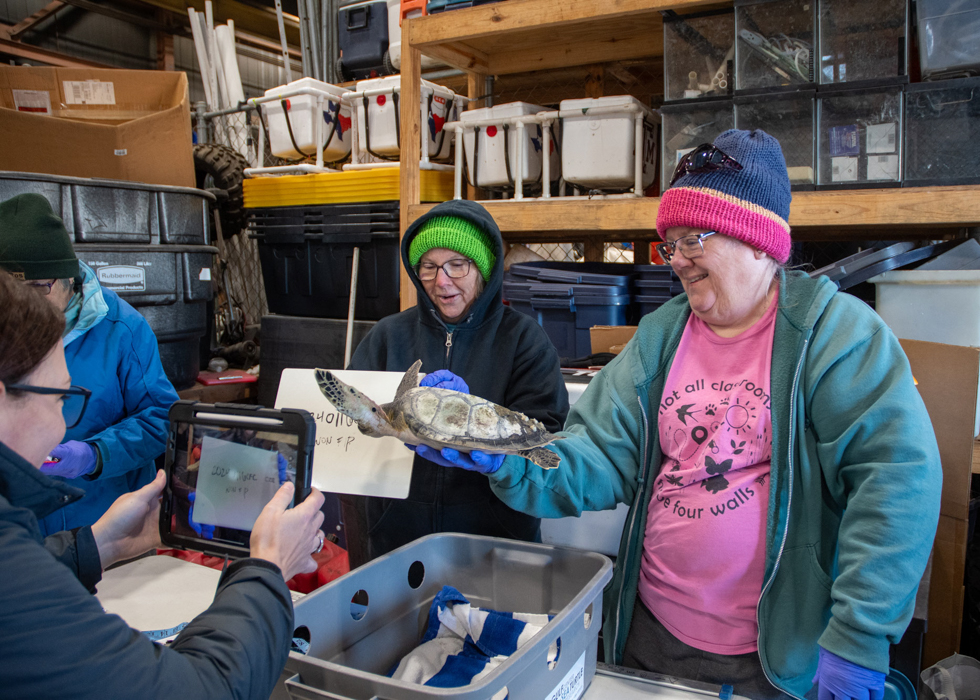Cold Weather Poses Threat To Gulf Sea Turtles
January 25, 2024
Tweet
By Taylor Bounds, Division of Marketing and Communications
As temperatures dropped earlier this week, many sea turtles found themselves struggling in the frigid water, some even stranded along the Texas coastline. Volunteers with the Gulf Center for Sea Turtle Research (GCSTR) braved subfreezing temperatures to surveil the beach and wade through the cold waters, searching for turtles in distress. At the same time, more volunteers gathered at Texas A&M University at Galveston, preparing for the intake of turtles so that a care team could start the rehabilitation process as soon as the transfer team arrived.
When water temperatures fall below 50 degrees Fahrenheit, sea turtles can become “cold-stunned” and enter a coma-like state. As reptiles, they depend on their environment to regulate their body temperature, so extended exposure to the cold can be fatal.
Though a cold front can be dangerous for these vulnerable animals, cold stunning is not the only danger sea turtles face. Sea turtles also fall victim to injury, illness or human activity, says Dr. Christopher Marshall, director of GCSTR and professor of marine biology at Texas A&M at Galveston.
Sometimes, sea turtles sustain injuries that are unrecoverable without intervention. When this happens, the turtle will be evaluated and rehabilitated and, depending on the animal’s condition, released back into the Gulf. Some turtles, due to their injury, will not survive in the wild. In those cases, they find permanent homes in places like the San Antonio Aquarium, where Slash, a former GCSTR patient, now thrives.
Sea turtles are also vulnerable to illness. In 2022, sea turtles were stranded en masse on the shores of the Gulf of Mexico. While experts aren’t sure what caused the illness, waves and wind pushed these emaciated turtles onto beaches. When something like this happens, the turtles are spotted by volunteers or beachgoers and reported through the Texas Sea Turtle Hotline at 1-866-TURTLE-5 (or 1-866-887-8535). Experts and volunteers respond by rescuing the animal and transporting it to a rehabilitation facility. Like turtles that have sustained injuries, sick turtles are taken to GCSTR, partner organizations or other turtle rescue organizations on the Gulf of Mexico. Some turtles may also suffer from tumors caused by the fibropapillomatosis (FP) virus. The virus occurs only in sea turtles, and while the tumors are benign, they can cause debilitating and potentially deadly issues if not removed.
Human activity poses the greatest risk to wildlife as a whole, and it is no different for sea turtles. They can get caught in or ingest trash and debris, be the victims of bycatch–incidentally being captured in fishermen's nets or fish hooks or can even get struck by propellers.
How can I help sea turtles?
If you see a sea turtle in trouble or spot a nest, call the Texas Sea Turtle Hotline at 1-866-TURTLE-5 (or 1-866-887-8535). The federal government gives all sea turtles legal protection in the United States and its waters under the Endangered Species Act; do not handle sea turtles without permission. The Texas Sea Turtle Hotline, in addition to monitoring done by volunteers and students, gives injured or sick turtles a chance to be rehabilitated, protects nests and allows for the collection of critical biological data to help conservation efforts for this endangered species.
Collecting trash and debris from beaches is another way to help sea turtles. Plastic pollution is a major threat to sea turtle health. By collecting litter, you can reduce the chances that a sea turtle will be harmed by human waste. Go the extra mile by reducing your daily use of single-use plastics and disposable items, and register to join GCSTR on March 12 at NestFest, the annual beach cleanup before turtle and shorebird nesting season.
You can support sea turtles by donating directly to the Gulf Center for Sea Turtle Research or the Upper Texas Coast Sea Turtle Hospital and Educational Outreach Center capital campaign fund.
You can also apply to join the Sea Turtle Rescue Team, which responds to sick, injured, entangled or deceased sea turtles stranded along the upper Texas coast. Due to federal protections, applicants will undergo training and permitting before handling any sea turtles.
###
Media contact:bounds@tamu.edu
More:
Read more about Health & Environment
Read more about Science & Technology
Read more about Marine Biology